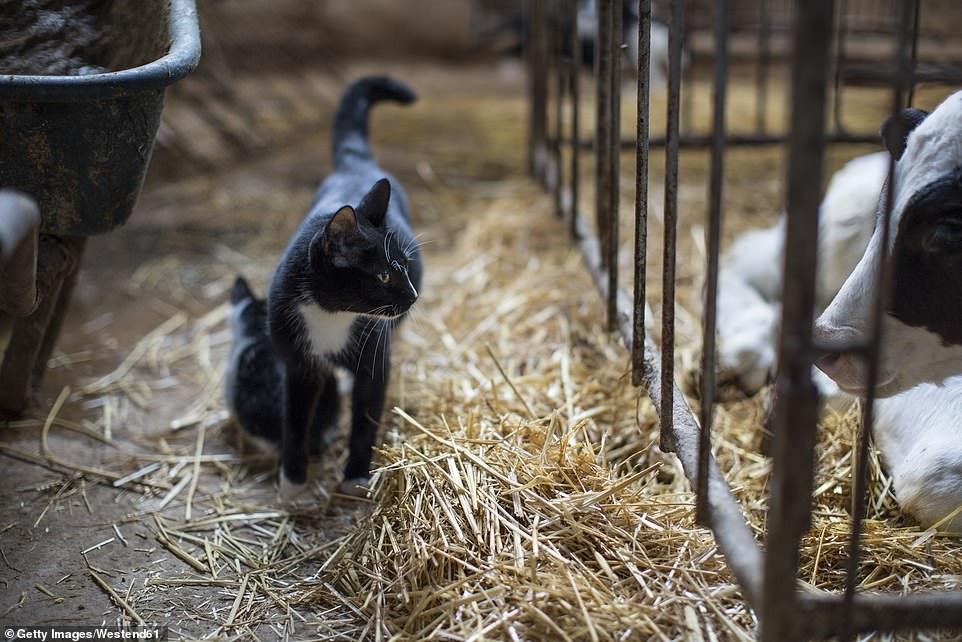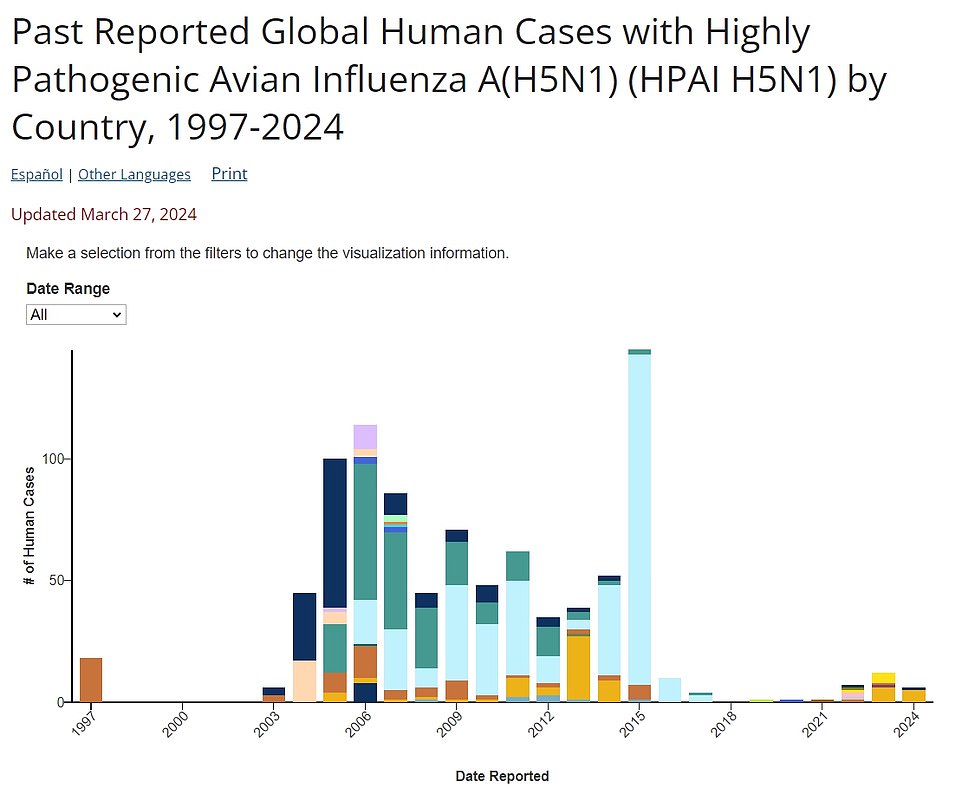The bird flu that infected Texas farm worker has mutated to spread more easily, CDC reveals — as three pets die from the virus and America’s largest egg producer is hit by an outbreak
The bird flu strain that infected a person in Texas has mutated to spread more easily, officials say — amid mounting concern the disease could spread to more people.
The CDC said tests on the H5N1 sample showed it had a mutation “known to be associated with viral adaptation to mammalian hosts” – but stressed that the mutations were small and the overall risk to the public was low.
This mutation was not detected in cattle or wild birds, and officials said the mutation “may have been acquired by the patient during the development of the (eye infection).”
Meanwhile, three domestic cats have reportedly died from bird flu after contracting the disease on Texas dairy farms – amid fears that infected animals living near humans could spread the disease to humans.
And the largest egg producer in the US has revealed that bird flu has been detected in its flock, with almost two million chickens now set to be culled. There are growing concerns that the outbreak on farms could cause supply chain problems or drive up the price of eggs and dairy products.
It comes amid concerns that H5N1 – which has already caused a pandemic in the animal world – could soon do the same in humans. The EU’s Food Safety Agency (EFSA) warned on Wednesday that a large-scale bird flu pandemic could emerge if the virus becomes transmissible between people.

A cat depicted in close contact with dairy cows. Three domestic cats on an infected Texas dairy farm have died after contracting H5N1 (stock image)
Infectious disease experts warn that any infection in mammals or humans increases the risk that the virus will acquire new mutations that allow it to infect humans.
Dr. Francois Balloux, an epidemiologist in Britain, warned on X that the situation “could ultimately change for the worse.”
But he added: ‘People who are not professionally involved in pandemic prevention/mitigation and who are now worried/miserable will not make any material difference to what may happen to us, except that their lives would be worthless , much more than it should be.’
Dr. Peter Hotez, a virologist at Baylor College of Medicine in Texas, told DailyMail.com that the cases were “a reminder that bird flu is circulating and constantly jumping to new mammalian hosts.”
“So far, the subsequent jumps into humans are still uncommon and do not cause serious disease,” he added, “but I believe this could eventually change.”
The mutation detected on the virus that infected a Texas dairy farm worker has been previously recorded, the CDC said — and did not cause a major outbreak at the time.
The change in the PB2 gene, linked to the way the virus makes copies of itself, has not been recorded in wild poultry or in infections in cows.

The above graph shows cases of bird flu in humans worldwide, reported per year. The colors represent different countries, with the light blue being Egypt and the orange being Cambodia
The CDC said: ‘It is important to note that this substitution has not been observed in available PB2 genes from viruses circulating in wild birds and poultry, or in the recently described bovine viruses detected in Texas.
‘(This suggests that) the mutation may have been acquired in the patient during the development of conjunctivitis.’
Bird flu makes millions of copies of itself in every cell it infects before bursting out to infect other nearby cells. Some of these copies contain mutations, with each new copy carrying the risk of creating a mutation that could help the virus infect or spread between people.
At this time, the infections in people in the US are reported to be mild – with the patient in Texas having one symptom: an eye infection, which was treated with antibiotics.
In the first US case of bird flu reported in a prison worker in 2022, the patient suffered from fatigue for only a few days.
There are also concerns about bird flu infections found in pets, which increases the risk of the virus spreading to people.
Yesterday, three domestic cats are said to have died after being infected with the virus at an affected dairy farm in Texas.
So far, seven dairy farms in Texas have reported outbreaks, along with two in Kansas and one each in New Mexico and Michigan. There are also suspicions about a new outbreak on a farm in Ames, Iowa.
Infected cows are reportedly ‘sleepy’, eat less food and produce less milk than before, even though they do not die from the disease.
At the same time, more outbreaks are being reported on poultry farms, leaving farmers with no choice but to cull their birds.
The largest egg producer in the US – Cal-Maine – announced yesterday that it would have to cull 2 million birds after the virus was discovered in its flock.
Officials in Michigan are also now urging people to take better measures to protect their herds.
This raises concerns about rising prices of milk and eggs.
Farmers are forced to throw away milk from infected animals, while egg producers are sidelined for months by culling their herds.
In 2022, egg prices rose by more than 50 percent in response to the outbreak – with a dozen large, grade A eggs costing $3.59 in November, compared to $1.72 the same time the year before. They peaked at $4.82 for a dozen eggs in January 2023.
Bird flu began to take off in 2020 after a wild bird flu swapped genes with a version of the virus from domestic poultry.
The disease spread rapidly through migratory birds and in May 2021 it was confirmed to have crossed the bird-mammal barrier for the first time – after two baby foxes in the Netherlands tested positive for the disease.
One died from the infection, while the other was euthanized due to symptoms. The route of infection was not confirmed, but scientists said it likely occurred through eating the carcass of an infected bird.
In January 2022, the first human case was diagnosed: 79-year-old Alan Gosling from Great Britain.
The former engineer had contracted the virus from one of the 20 Muscovy ducks he shared his home with – and had only mild symptoms.
Barely three months later a second human case was reported in an inmate working on a poultry farm in Colorado.
The patient also had only mild symptoms – ‘fatigue for a few days’ – and later recovered after taking the antiviral drug oseltamivir.
In November 2022, China recorded its first death from the virus – in a poultry farm worker infected with H5N1.
Sporadic cases have been discovered since then, but experts say the numbers are still much lower than the outbreak in Egypt around 2015 – when more than a hundred cases were discovered.
Bird flu began spreading to domestic birds in February 2022, when the US revealed it had detected H5N1 in a flock of turkeys.
That year alone, an estimated 52 million birds had to be culled to prevent the spread of the virus, driving up the price of eggs and chicken meat.
More culling occurred in 2023 and again this year, with the total number of birds culled now estimated at more than 82 million.
There are also concerns that the virus could spread to other animals that come into closer contact with humans after a dog in Ottawa, Canada, tested positive in April 2023.
And there are signs the disease may be spreading among mammals, including seals, after 17,000 pups died in a colony in Patagonia.
Experts said at the time that the animals were infected with bird flu and warned that the flu was likely spreading between animals at the site.
